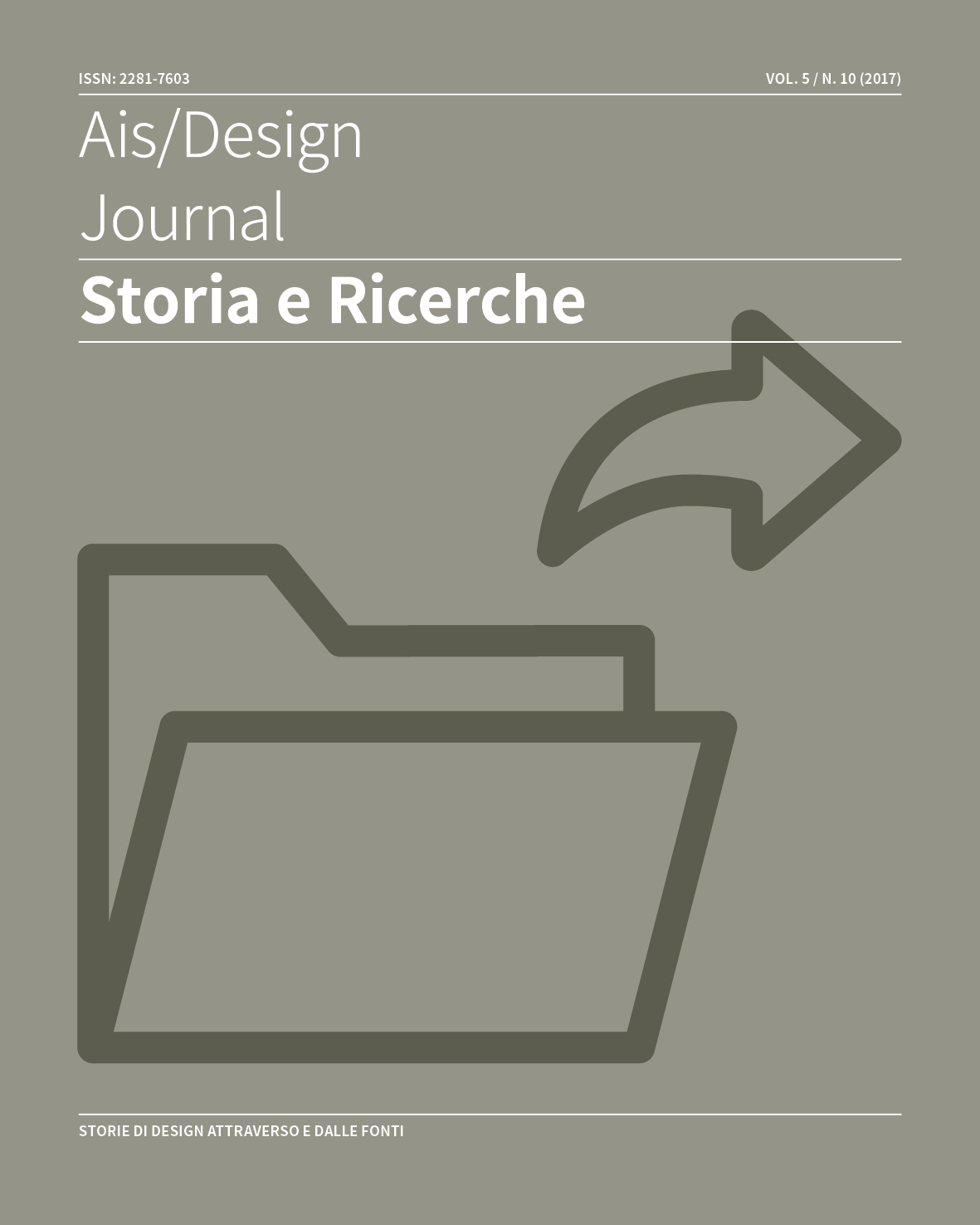Design Histories Through and From Sources
Abstract
After over four years of publication (the first issue came out in March 2013), «AIS/Design. Storia e Ricerche» celebrates its tenth issue by again featuring – following a series of monograph issues – research studies covering a range of themes. Yet in this case, there is a common thread tying the heterogeneous topics together: methodological considerations on the study and use of primary sources.
As we wrote in the call we launched a year ago, we felt it was appropriate to focus attention back on the historian’s primary working tools, sources and archives, at a time in which we are witnessing an apparently contradictory set of phenomena and trends in the field of historical elaboration and analysis.
While on the one hand, we observe that the narrative dimension is beginning to prevail in the ways that historical events are reconstructed and presented to the public, in a search for greater legibility and more immediate and emotional involvement of the reader, on the other hand, the relationship with the sources has been immeasurably transformed and enriched, at least in terms of power, by digital technology in particular, which is contributing new tools and stimuli to research work. Offering access to a greater quantity and variety of sources, the digital remediation of documents and materials of various kinds, generated on different types of media, opens new possibilities for exploring and using them, but also calls for a reflection on their interpretation.
This is a time in which historians are advancing across an expanded geography of resources, a landscape of sources ranging from specificity to uniformity in which the challenge, at least for design history, of diversifying the tools and more significantly the methodologies, remains to be clarified and addressed. The questions of method most certainly concern the nature of the digital sources – both those produced by a process of digitization and native digital sources – but the debate also touches upon other typologies of sources that are relatively less attended to, or better, not yet systemized by the historiography of design, such as oral sources, the characteristics of which are quite different from linguistic and written media, or audio or video recordings.
Naturally, the ambition of this issue is not to address each and every one of these problems. Titled “Design histories through and from the sources”, it brings to light in each of the articles a critical reflection on the materials themselves, on their variety, their accessibility or relative inaccessibility. In other words, what we asked the authors to do was to highlight the tools they worked with and the role they played in shaping their research, in an effort to recombine method and content, underscoring the role of the sources in historical research.
For this reason, many of the articles published here share a self-reflecting approach; several authors have used their own investigations as case studies, opening a series of windows onto pragmatic or methodological, operational or conceptual issues in historiographic work. This is the case with the essays by Bahar Emgin, Ida Kamilla Lie, Paola Proverbio, Eleonora Charans, Chiara Lecce, Marta Sironi, Luciana Gunetti and those of Elena Dellapiana, Tanja Marzi and Federica Stella. Their essays offer ideas and references – borrowed from various disciplines, such as architectural history, philology, archival studies, public history, oral history, Actor Network Theory – that confirms the need to continue expanding the horizons for the study of design history, and at the same time to systemize adequate approaches and practices.
The article by Dario Scodeller moves in the same direction, concentrating on issues related to the digitization of sources.
Overall, the articles provide a significant sampler of the ways in which the analysis of primary sources can offer new perspectives on the history of design; methodological and operational ideas and opportunities deriving from the heterogeneity of the sources and media, and from the tools used to analyse them; the typologies of sources that may be used to study the different histories of design (in various national contexts); the role of the people involved in the processes of preservation, selection, use and interpretation of the sources, from the historians to the people responsible for the archives, to the designers themselves.
This issue also includes a review of Victor Margolin’s World History of Design – as well as the first version of the new online editorial platform by Bloomsbury Publishing – https://www.bloomsburydesignlibrary.com/ – and a review of two recent exhibitions dedicated to the history of La Rinascente department store, organized in Milan and in Chiasso, Switzerland, for its one-hundredth anniversary.
Finally, Claudia Collina, a civil servant specialized in the Cultural Heritage, illustrates the premises and results of a wide-ranging research study on various typologies of museums and collections featuring design objects, found in the cultural institutions of the Emilia-Romagna region.
The publication of our tenth issue offers us the opportunity to thank all those who have contributed to the growth of the magazine, to thank our team, all of whom have made it possible, on a voluntary basis, to achieve this result. We also take this opportunity to pledge our commitment to the future.
Copyright (c) 2017 Fiorella Bulegato, Maddalena Dalla Mura, Raimonda Riccini, Carlo Vinti

This work is licensed under a Creative Commons Attribution-NonCommercial-NoDerivatives 4.0 International License.
Creative Commons NonCommercial-NoDerivates 4.0 international License (CC BY-NC-ND 4.0).


